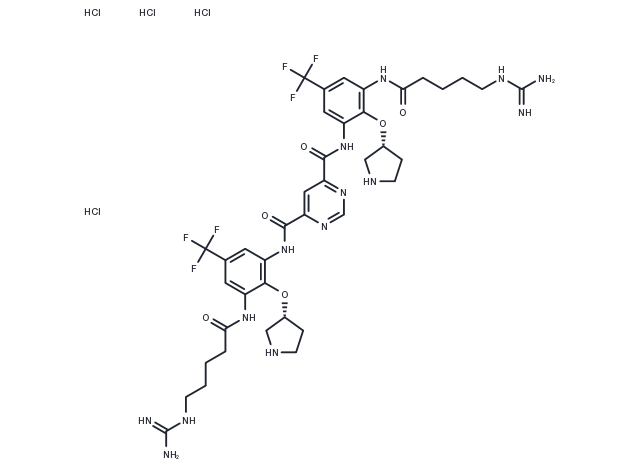Powder: -20°C for 3 years | In solvent: -80°C for 1 year


Brilacidin tetrahydrochloride (PMX 30063 tetrahydrochloride) is a defensin mimetic antibiotic compound, exhibiting potent anti-infective antimicrobial activity against a range of bacteria. It demonstrates MIC90 values of 1 μg/mL and 8 μg/mL against the Gram-positive bacteria Streptococcus pneumoniae and Streptococcus viridans, respectively. Additionally, it has a MIC90 value of 8 μg/mL for the Gram-negative bacteria Haemophilus influenzae and a MIC90 value of 4 μg/mL for Pseudomonas aeruginosa.

| Pack Size | Availability | Price/USD | Quantity |
|---|---|---|---|
| 50 mg | Inquiry | Inquiry | |
| 100 mg | Inquiry | Inquiry |
| Description | Brilacidin tetrahydrochloride (PMX 30063 tetrahydrochloride) is a defensin mimetic antibiotic compound, exhibiting potent anti-infective antimicrobial activity against a range of bacteria. It demonstrates MIC90 values of 1 μg/mL and 8 μg/mL against the Gram-positive bacteria Streptococcus pneumoniae and Streptococcus viridans, respectively. Additionally, it has a MIC90 value of 8 μg/mL for the Gram-negative bacteria Haemophilus influenzae and a MIC90 value of 4 μg/mL for Pseudomonas aeruginosa. |
| In vitro | Both Staphylococcus aureus (SA) and Staphylococcus epidermidis (SE) exhibit the lowest minimum inhibitory concentrations (MIC) compared to other bacterial groups studied. The MIC90s for Brilacidin against Streptococcus pneumonia (SP), Streptococcus viridians (SV), Moraxella (MS), Haemophilus influenza (HI), Pseudomonas aeruginosa (PA), and Serratia marcescens (SM) show a marked increase, being 4, 32, 256, 32, 16, and 128 times higher, respectively, than those for SA and SE. Brilacidin demonstrates significant in vitro activity against Gram-positive bacteria, with the exception of SV, and is considerably less effective against Gram-negative bacteria. Topically applied 0.5% Brilacidin solution is minimally irritating and was found to be as effective as Vancomycin (VAN) in a methicillin-resistant S. aureus (MRSA) keratitis model, particularly when the corneal epithelium had been removed. The mechanism of action for Brilacidin primarily involves the depolarization of the bacterial cell membrane, highlighting its potent antibacterial properties, especially against Gram-positive strains. |
| In vivo | In the NZW rabbit ocular toxicity model, Brilacidin exhibits dose-dependent ocular toxicity following seven topical applications every 30 minutes over a three-hour period. A 1% concentration of Brilacidin is classified as Mildly Irritating with a Maximum mean total score (MMTS) of 23.0. Concentrations of 0.5% (MMTS: 6.5) and 0.25% (MMTS: 4.0) are deemed Minimally Irritating. In contrast, a 0.1% solution of Brilacidin, with an MMTS of 2.0, and TBS with an MMTS of 1.0, are categorized as Practically Nonirritating. Moreover, a 0.01% concentration of Brilacidin, showing an MMTS of 0.5, is identified as Nonirritating. |
| Synonyms | PMX 30063 tetrahydrochloride |
| Molecular Weight | 1082.75 |
| Formula | C40H54Cl4F6N14O6 |
| CAS No. | 1224095-99-1 |
Powder: -20°C for 3 years | In solvent: -80°C for 1 year
You can also refer to dose conversion for different animals. More
bottom
Please see Inhibitor Handling Instructions for more frequently ask questions. Topics include: how to prepare stock solutions, how to store products, and cautions on cell-based assays & animal experiments, etc.
Brilacidin tetrahydrochloride 1224095-99-1 Brilacidin Tetrahydrochloride PMX-30063 PMX 30063 tetrahydrochloride PMX 30063 Tetrahydrochloride Brilacidin PMX30063 Tetrahydrochloride PMX 30063 PMX30063 PMX-30063 Tetrahydrochloride inhibitor inhibit
